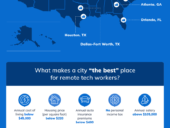
CXO
CXOTop Tech Conferences & Events to Add to Your Calendar in 2024
A great way to stay current with the latest technology trends and innovations is by attending conferences. Read and bookmark our 2024 tech events guide.

A great way to stay current with the latest technology trends and innovations is by attending conferences. Read and bookmark our 2024 tech events guide.

Bain & Company, which tops the U.S. list, and Google are the only two companies that have been included in the U.S. rankings every year of Glassdoor's Employees' Choice Awards.

Be cautious of the generative AI bubble potentially bursting, Deloitte said. Plus, cloud sovereignty may be hot in 2024.

The newly formed AI alliance was spearheaded by IBM and Meta and includes more than 50 members in business, academia, government and advocacy.

According to Gartner, the next wave of cloud computing will see even more complicated workloads migrated over, plus new options and requirements for cloud customers.

Research has found that criminals can demand higher ransom when they compromise an organisation’s backup data in a ransomware attack. Discover advice from security experts on how to properly protect your backup.

Generative AI is finding its niches within business in 2024, with multimodal models providing new capabilities. At the same time, artists glaze their work against AI scraping.

How much better is GPT-4 compared to previous models? Learn about cost and capabilities.

Find out why IT pros in Australia need to take the initiative to self-upskill, and learn how this could lead to salary increases and promotions.

Today’s options for best AI courses offer a wide variety of hands-on experience with generative AI, machine learning and AI algorithms.

From generative AI and virtual prototyping to the Internet of Things, blockchain and data analytics, Merkle has predicted that four shifts in the business-to-business market will shape tech buying appetites.

A cyber security expert from Tenable has called on large tech platforms to do more to identify AI deepfakes for users, while APAC organisations may need to include deepfakes in risk assessments.

Generative artificial intelligence has rapidly gained traction amongst businesses, professionals and consumers. But what is generative AI, how does it work and what is all the buzz about? Read on to find out.

Cyber security operatives have been warned to look at the specific ransomware threats facing their country and industry, while closing down common pathways being used by skilled access brokers.

Of the IT and security professionals surveyed, 63% said AI will improve security within their organization.

TechRepublic Premium content helps you solve your toughest IT issues and jump-start your career or next project.

A great way to stay current with the latest technology trends and innovations is by attending conferences. Read and bookmark our 2024 tech events guide.

Using a CRM system gives businesses the tools to improve their customer relationships, streamline their sales processes and leverage the platform to achieve success.

One advantage of working remotely is the freedom to choose where to reside that matches one’s needs. Discover the best cities for remote tech workers in this analysis.

This bundle gives you lifetime access to 2019 versions of Excel, Word, Outlook, PowerPoint, Access, Publisher and One Note with no subscription or license fees.